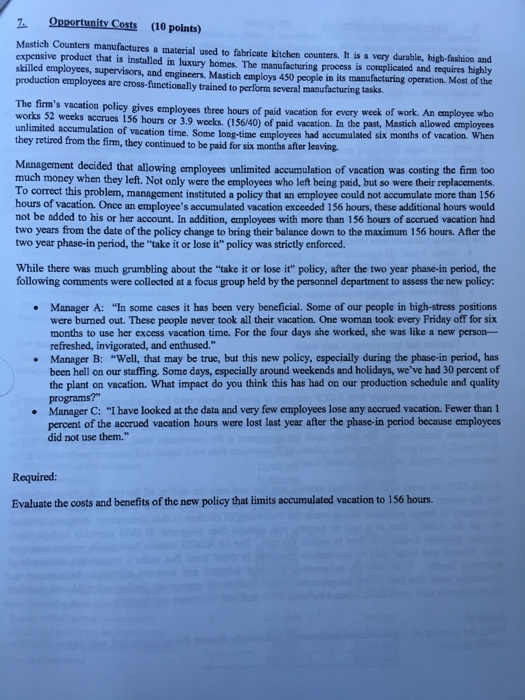Mastich Counters manufactures a material used to fabricate kitchen counters. It is a very durable, high-fashion and expensive product that is installed in luxury homes. The manufacturing process is complicated and requires highly skilled employees, supervisors, and engineers. Mastich employs 450 people in its manufacturing operation. Most of the production employees are cross-functionally trained to perform several manufacturing tasks. The firm's vacation policy gives employees three hours of paid vacation for every week of work. An employee who works 52 weeks accrues 156 hours or 3.9 weeks. (156/40) of paid vacation. In the part, Mastich allowed employees unlimited accumulation of vacation time. Some long-time employees had accumulated six months of vacation. When they retired from the firm, they continued to be paid for six months after leaving. Management decided that allowing employees unlimited accumulation of vacation was costing the firm too much money when they left. Not only were the employees who left being paid, but so were their replacements. To correct this problem, management instituted a policy that an employee could not accumulate more than 156 hours of vacation. Once an employee's accumulated vacation exceeded 156 hours, these additional hours would not be added to his or her account. In addition, employees with more than 156 hours of accrued vacation had two years from the date of the policy change to bring their balance down to the maximum 156 hours. After the two year phase-in period, the "take it or lose it" policy was strictly enforced. While there was much grumbling about the "take it or lose it" policy, after the two year phase-in period, the following comments were collected at a focus group held by the personnel department to assess the new policy. Manager A: "In some eases it has been very beneficial. Some of our people in high-stress positions were burned out. These people never took all their vacation. One woman took every Friday off for six months to use her excess vacation time. For the four days she worked, she was like a new person refreshed, invigorated, and enthused." Manager B: "Well, that may be true, but this new policy, especially during the phase-in period, has been hell on our staffing. Some days, especially around weekends and holidays, we've had 30 percent of the plant on vacation. What impact do you think this has had on our production schedule and quality programs?" Manager C: "I have looked at the data and very few employees lose any accrued vacation. Fewer than 1 percent of the accrued vacation hours were lost last year after the phase-in period because employees did not use them." Evaluate the costs and benefits of the new policy that limits accumulated vacation to 156 hours. Mastich Counters manufactures a material used to fabricate kitchen counters. It is a very durable, high-fashion and expensive product that is installed in luxury homes. The manufacturing process is complicated and requires highly skilled employees, supervisors, and engineers. Mastich employs 450 people in its manufacturing operation. Most of the production employees are cross-functionally trained to perform several manufacturing tasks. The firm's vacation policy gives employees three hours of paid vacation for every week of work. An employee who works 52 weeks accrues 156 hours or 3.9 weeks. (156/40) of paid vacation. In the part, Mastich allowed employees unlimited accumulation of vacation time. Some long-time employees had accumulated six months of vacation. When they retired from the firm, they continued to be paid for six months after leaving. Management decided that allowing employees unlimited accumulation of vacation was costing the firm too much money when they left. Not only were the employees who left being paid, but so were their replacements. To correct this problem, management instituted a policy that an employee could not accumulate more than 156 hours of vacation. Once an employee's accumulated vacation exceeded 156 hours, these additional hours would not be added to his or her account. In addition, employees with more than 156 hours of accrued vacation had two years from the date of the policy change to bring their balance down to the maximum 156 hours. After the two year phase-in period, the "take it or lose it" policy was strictly enforced. While there was much grumbling about the "take it or lose it" policy, after the two year phase-in period, the following comments were collected at a focus group held by the personnel department to assess the new policy. Manager A: "In some eases it has been very beneficial. Some of our people in high-stress positions were burned out. These people never took all their vacation. One woman took every Friday off for six months to use her excess vacation time. For the four days she worked, she was like a new person refreshed, invigorated, and enthused." Manager B: "Well, that may be true, but this new policy, especially during the phase-in period, has been hell on our staffing. Some days, especially around weekends and holidays, we've had 30 percent of the plant on vacation. What impact do you think this has had on our production schedule and quality programs?" Manager C: "I have looked at the data and very few employees lose any accrued vacation. Fewer than 1 percent of the accrued vacation hours were lost last year after the phase-in period because employees did not use them." Evaluate the costs and benefits of the new policy that limits accumulated vacation to 156 hours







